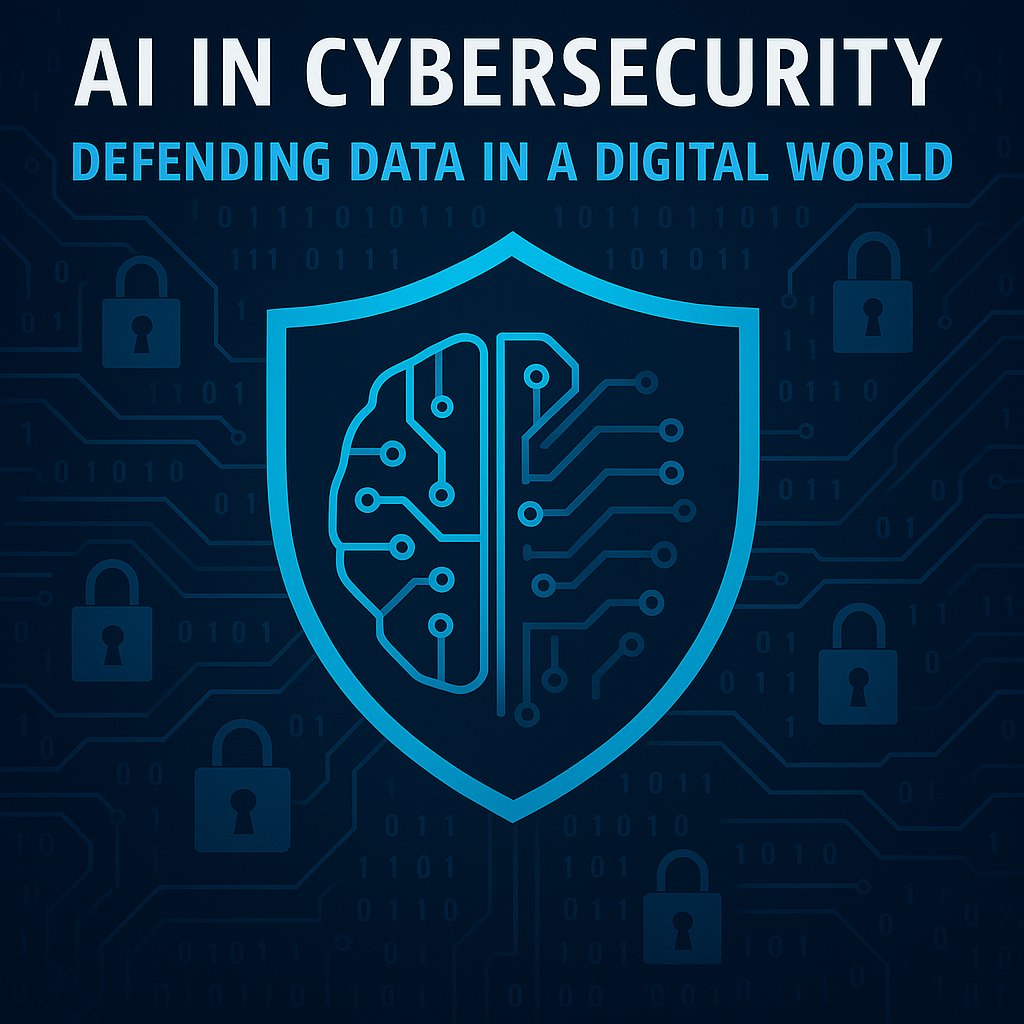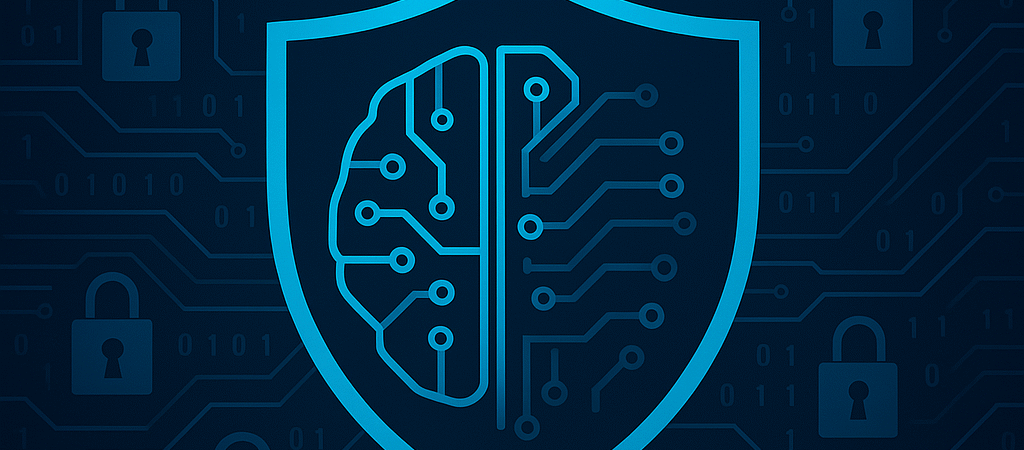Introduction
In today’s modern digital world, cybersecurity has become more crucial than ever. As businesses, governments, and individuals increasingly rely on digital platforms, the importance of protecting sensitive data and systems from cyber attacks cannot be overstated. The rising complexity and volume of cyber threats from ransomware and phishing to sophisticated state-sponsored attacks pose significant challenges to traditional security measures.
Amid this growing threat landscape, Artificial Intelligence (AI) is emerging as a powerful defense tool. By leveraging advanced algorithms and machine learning, AI enhances the ability to detect, prevent, and respond to cyber threats more efficiently and accurately than ever before.
In this blog, we will explore how AI is revolutionizing cybersecurity, transforming the way we safeguard data in an increasingly digital world.

What is AI in Cybersecurity?
Artificial Intelligence (AI) in cybersecurity refers to the application of advanced algorithms and intelligent technologies to protect digital systems, networks, and sensitive data from cyber threats. By leveraging AI, cybersecurity tools can analyze vast volumes of data, identify patterns, and make decisions much faster and more accurately than traditional methods. This capability allows for real-time threat detection, automated responses, and continuous learning from emerging attack techniques.
Key Technologies in AI for Cybersecurity
- Machine Learning (ML): Machine learning enables cybersecurity systems to learn from historical data and recognize patterns associated with malicious activity. Over time, these systems improve their accuracy in detecting threats without needing explicit programming for every new attack.
- Deep Learning: A more advanced form of machine learning, deep learning uses neural networks to analyze complex and unstructured data, such as images or network traffic, to uncover hidden threats and subtle anomalies that might evade simpler detection methods.
- Natural Language Processing (NLP): NLP helps AI understand and interpret human language, which is particularly useful in detecting phishing emails, malicious messages, or social engineering attempts by analyzing the content and context of communications.
How AI Differs from Traditional Cybersecurity Solutions
Traditional cybersecurity solutions generally rely on fixed rules, signature-based detection, and manual monitoring, which can struggle to keep pace with the rapidly evolving threat landscape. In contrast, AI-powered cybersecurity systems are adaptive and proactive. They continuously learn from new data, enabling them to detect previously unknown threats and zero-day attacks. AI automates many routine security tasks such as vulnerability scanning, log analysis, and incident response, reducing human error and increasing efficiency.
Moreover, AI excels at identifying subtle behavioral anomalies across networks and endpoints, which traditional tools might overlook. This ability to predict and prevent attacks before they cause damage marks a significant shift in cybersecurity strategy. By combining speed, adaptability, and intelligence, AI is transforming how organizations defend their digital assets in an increasingly complex cyber environment.
Why Traditional Cybersecurity Isn’t Enough Anymore
The cybersecurity landscape is evolving at an unprecedented pace, with increasingly sophisticated threats such as zero-day attacks, ransomware, and phishing campaigns becoming more frequent and complex. Zero-day attacks exploit previously unknown vulnerabilities, leaving traditional signature-based defenses powerless until patches are developed and deployed. Ransomware attacks have grown more targeted and damaging, often crippling entire organizations by encrypting critical data and demanding hefty payments. Phishing techniques continue to evolve, using social engineering to deceive even the most cautious users. These dynamic threats expose the limitations of conventional cybersecurity approaches that rely heavily on static rules and known threat signatures.
Additionally, human limitations present a significant challenge in real-time detection and response. Cybersecurity analysts face overwhelming volumes of alerts and data, making it difficult to identify genuine threats quickly and accurately. The sheer scale of data generated by modern networks leads to information overload, where critical signals can be lost amid noise. This often results in high rates of false positives, where benign activities are mistakenly flagged as malicious, causing alert fatigue and diverting valuable resources away from real threats. Traditional tools struggle to keep pace with this flood of data and the speed at which attacks can unfold.
In this environment, relying solely on human-driven, rule-based security measures is no longer sufficient. Organizations need adaptive, intelligent systems capable of processing vast amounts of data, discerning subtle patterns, and responding instantly to emerging threats. This gap is precisely where AI-powered cybersecurity solutions excel, offering the ability to augment human expertise with automation, predictive analytics, and continuous learning, thereby transforming the defense posture against modern cyber threats.
Top Applications of AI in Cybersecurity
AI is rapidly transforming cybersecurity by enabling more effective and efficient defense mechanisms across multiple critical areas. One of the foremost applications is threat detection and anomaly recognition, where AI-powered systems analyze vast amounts of network traffic and user behavior data in real time to identify unusual patterns that may signal cyberattacks. Unlike traditional tools that rely on known signatures, AI uses machine learning to detect novel and evolving threats, significantly reducing detection times and minimizing damage.
Another key application is fraud prevention and behavioral analysis. AI models monitor user activities and transaction patterns to spot suspicious behavior indicative of fraud, such as unusual login locations or abnormal spending habits. This capability is especially vital in sectors like finance, where real-time fraud detection can prevent significant monetary losses. Behavioral analytics driven by AI also help organizations understand baseline user behavior, enabling more accurate identification of insider threats or compromised accounts.
Automated incident response is another area where AI excels. By automating routine security tasks—such as isolating infected devices, blocking malicious IP addresses, or applying patches—AI reduces response times and alleviates the burden on security teams. This automation allows cybersecurity professionals to focus on more complex investigations and strategic planning, enhancing overall security posture.
AI also plays a crucial role in email and phishing detection. Using natural language processing and pattern recognition, AI systems can analyze the content, sender behavior, and metadata of emails to detect phishing attempts and malicious attachments with high accuracy. This is essential as phishing remains one of the most common and effective attack vectors.
Finally, AI strengthens endpoint and network security by continuously monitoring devices and network traffic for signs of compromise. AI-driven solutions can identify zero-day exploits and advanced persistent threats by correlating data from multiple sources and adapting to new attack techniques. This holistic approach provides organizations with dynamic, real-time protection across their entire digital infrastructure.
Together, these AI applications are reshaping cybersecurity by enhancing threat visibility, accelerating response, and enabling predictive defense strategies that keep pace with today’s rapidly evolving cyber threat landscape.
Benefits of Using AI in Cybersecurity
AI brings transformative benefits to cybersecurity by enhancing the speed, accuracy, and scalability of threat detection and response. One of the most significant advantages is real-time threat detection. AI systems can continuously monitor vast amounts of network traffic and user behavior, quickly identifying anomalies and emerging threats that traditional methods might miss. This immediate detection is crucial for minimizing damage and preventing breaches before they escalate. Coupled with this is the reduced response time AI enables; automated incident response tools can isolate compromised devices, block malicious activity, and alert security teams instantly, dramatically shortening the window attackers have to cause harm.
Another key benefit is the reduction of false positives and improved accuracy. Traditional cybersecurity solutions often overwhelm analysts with alerts, many of which are benign, leading to alert fatigue and missed genuine threats. AI’s ability to analyze context and patterns helps filter out noise, allowing security teams to focus on real risks and make better-informed decisions. This precision also enhances scalability across large systems, as AI can handle and analyze massive data volumes from complex infrastructures without requiring proportional increases in human resources. As organizations grow and generate more data, AI ensures security operations remain effective and manageable.
From a financial perspective, AI contributes to cost-efficiency over time. By automating routine and time-consuming security tasks—such as log analysis, vulnerability scanning, and compliance monitoring—AI reduces the need for large security teams and lowers operational costs. It also helps prevent costly breaches by enabling faster detection and response, protecting valuable data and maintaining customer trust. Overall, AI empowers organizations to build more resilient, adaptive, and efficient cybersecurity defenses that keep pace with today’s rapidly evolving threat landscape.
Challenges and Limitations of AI in Cybersecurity
While AI offers powerful advantages in cybersecurity, it also presents several significant challenges and limitations that organizations must carefully address. One major concern involves data privacy and ethical issues. AI systems often require access to vast amounts of sensitive data to train models and detect threats effectively. Handling such data raises privacy risks, especially in regulated industries like healthcare and finance, where compliance with laws such as GDPR, HIPAA, and PCI DSS is mandatory. Moreover, AI algorithms can inadvertently introduce biases, potentially leading to unfair or discriminatory outcomes, such as misclassifying certain user behaviors or groups as threats. Ensuring transparency, accountability, and ethical use of AI remains a complex and ongoing challenge.
Another critical limitation is the threat of adversarial AI and AI-powered attacks. Cybercriminals are increasingly leveraging AI themselves to develop more sophisticated threats, such as AI-generated phishing emails that are difficult to distinguish from legitimate communications, or AI-driven malware that can evade traditional detection. Attackers may also use adversarial techniques like data poisoning—manipulating training data to cause AI models to misclassify attacks—or evasion attacks that exploit blind spots in AI defenses. This creates an ongoing arms race where defenders must constantly update AI models to counter evolving AI-enabled threats.
The effectiveness of AI in cybersecurity heavily depends on the quality and quantity of training data. Poor, incomplete, or biased data can degrade AI performance, leading to inaccurate threat detection or excessive false positives. Additionally, integrating AI tools with existing legacy systems can be technically complex and resource-intensive, requiring specialized expertise and careful planning to avoid operational disruptions.
Finally, the high implementation and maintenance costs pose a significant barrier for many organizations. Deploying AI-based cybersecurity solutions often demands substantial upfront investment in hardware, software licenses, and skilled personnel such as data scientists and security architects. Ongoing maintenance—including model retraining, data updates, and performance tuning—adds to the complexity and expense, which can be prohibitive for smaller enterprises.
In summary, while AI is revolutionizing cybersecurity, its adoption must be balanced with careful management of privacy, ethical, technical, and financial challenges to ensure effective, trustworthy, and sustainable defense capabilities.
Case Studies and Real-World Examples
AI’s transformative impact on cybersecurity is vividly demonstrated in real-world applications across industries, particularly in financial institutions and Security Operations Centers (SOCs). One prominent example is the use of AI in financial institutions for fraud detection and prevention. Global Bank Corp, a major financial institution managing trillions in assets, implemented AI-driven cybersecurity measures to combat sophisticated threats such as phishing, ransomware, and advanced persistent threats. By integrating AI algorithms into their next-generation SOC, the bank significantly enhanced its ability to detect irregular patterns and potential breaches in real time. This resulted in an 80% reduction in successful phishing attempts and improved compliance with global financial regulations, safeguarding customer data and reinforcing trust1. Similarly, other financial institutions employ AI-powered behavioral analysis and machine learning to monitor transactions and user activities, enabling more accurate fraud detection while minimizing false positives, thereby improving both security and customer experience23.
In the broader cybersecurity landscape, AI-powered Security Operations Centers (SOCs) have become essential for proactive threat management. Companies like Darktrace leverage AI to provide continuous network monitoring and anomaly detection, using unsupervised machine learning to spot subtle deviations that may indicate cyberattacks. Darktrace’s AI-driven approach allows organizations to respond to threats autonomously and in real time, reducing the window of vulnerability. IBM Watson for Cybersecurity is another leading example, combining natural language processing and vast threat intelligence databases to assist security analysts in identifying and responding to complex threats faster and more effectively. Watson’s AI capabilities enable the correlation of disparate data sources and provide actionable insights that enhance decision-making in SOC environments.
These case studies underscore how AI is revolutionizing cybersecurity by enabling faster detection, smarter response, and more efficient management of cyber risks. Financial institutions and cybersecurity firms alike are harnessing AI technologies to stay ahead of increasingly sophisticated cyber threats, demonstrating that AI is no longer just an emerging tool but a critical component of modern cybersecurity defense.
The Future of AI in Cybersecurity
The future of AI in cybersecurity is poised to be defined by increasingly sophisticated and proactive defense mechanisms, driven largely by predictive security models. These models leverage advanced machine learning algorithms to analyze vast datasets and identify potential vulnerabilities or attack vectors before they are exploited, shifting cybersecurity from a reactive to a proactive discipline. By anticipating threats, organizations can implement preventative measures that reduce the risk of breaches and minimize damage.
Another significant trend is the deepening integration of AI with Internet of Things (IoT) and edge computing environments. As billions of IoT devices generate massive amounts of data at the network edge, AI-powered security solutions will be essential to monitor and protect these decentralized systems in real time. Edge AI enables faster threat detection and response locally, reducing latency and dependence on centralized cloud systems, which is critical for maintaining security in smart homes, industrial control systems, and connected healthcare devices.
The evolving cyber warfare landscape will increasingly feature a complex battle of AI versus AI, where defensive AI systems must counteract offensive AI-driven attacks. Cyber adversaries are already harnessing AI to craft highly realistic phishing campaigns, adaptive malware, and deepfake impersonations that can evade traditional defenses. This arms race demands that defenders deploy equally advanced AI tools capable of learning from and adapting to these sophisticated threats in real time, creating a dynamic battlefield where AI technologies continuously evolve on both sides.
A crucial component in the future adoption of AI in cybersecurity is the rise of explainable AI (XAI), which aims to make AI decision-making processes transparent and understandable to human operators. Building trust in AI systems is essential, especially in high-stakes environments where security decisions can have significant consequences. XAI helps security teams validate AI-driven alerts and responses, ensuring they can interpret and justify actions taken by AI tools. This transparency not only improves collaboration between humans and AI but also supports regulatory compliance and ethical standards.
In summary, the future of AI in cybersecurity will be characterized by predictive, adaptive, and transparent AI systems integrated across diverse digital environments, enabling organizations to stay ahead of increasingly sophisticated cyber threats while maintaining trust and control over automated defenses.
Conclusion
AI holds immense potential in defending digital assets by fundamentally transforming the way cybersecurity operates. Through advanced capabilities such as real-time threat detection, anomaly recognition, automated incident response, and continuous learning from emerging attack patterns, AI empowers organizations to identify and mitigate cyber risks more quickly and accurately than ever before. This leads to faster containment of threats, reduced operational downtime, and stronger protection of sensitive data across complex digital environments. Moreover, AI’s ability to scale across large systems and automate routine security tasks enhances both efficiency and cost-effectiveness, allowing security teams to focus on strategic initiatives rather than being overwhelmed by alert fatigue.
However, alongside these substantial benefits, AI in cybersecurity also presents significant challenges that must be carefully managed. Data privacy and ethical concerns arise from the extensive data collection and analysis required to train AI models, raising questions about compliance and fairness. The emergence of adversarial AI and AI-powered attacks introduces a new dimension to the cybersecurity arms race, where attackers use AI to evade detection and launch more sophisticated threats. Additionally, the effectiveness of AI depends heavily on the quality and diversity of training data, and poor data can lead to inaccuracies or bias in threat detection. High implementation and maintenance costs can also be barriers for many organizations, especially smaller enterprises with limited resources.
Balancing these benefits and challenges is essential for realizing AI’s full potential in cybersecurity. Organizations must adopt a thoughtful approach that incorporates robust data governance, continuous model evaluation, and ethical considerations to ensure AI systems are both effective and trustworthy. Looking ahead, cybersecurity will increasingly rely on intelligent, adaptive technologies that not only augment human expertise but also provide predictive, proactive defense capabilities. Explainable AI will play a critical role in building trust and transparency, enabling security teams to understand and validate AI-driven decisions. In this evolving landscape, embracing AI is no longer optional but a strategic imperative for organizations seeking to protect their digital assets against ever-more sophisticated cyber threats. The future of cybersecurity lies in the seamless integration of human insight and AI-powered intelligence, creating resilient defenses that can anticipate, detect, and respond to threats in real time.

